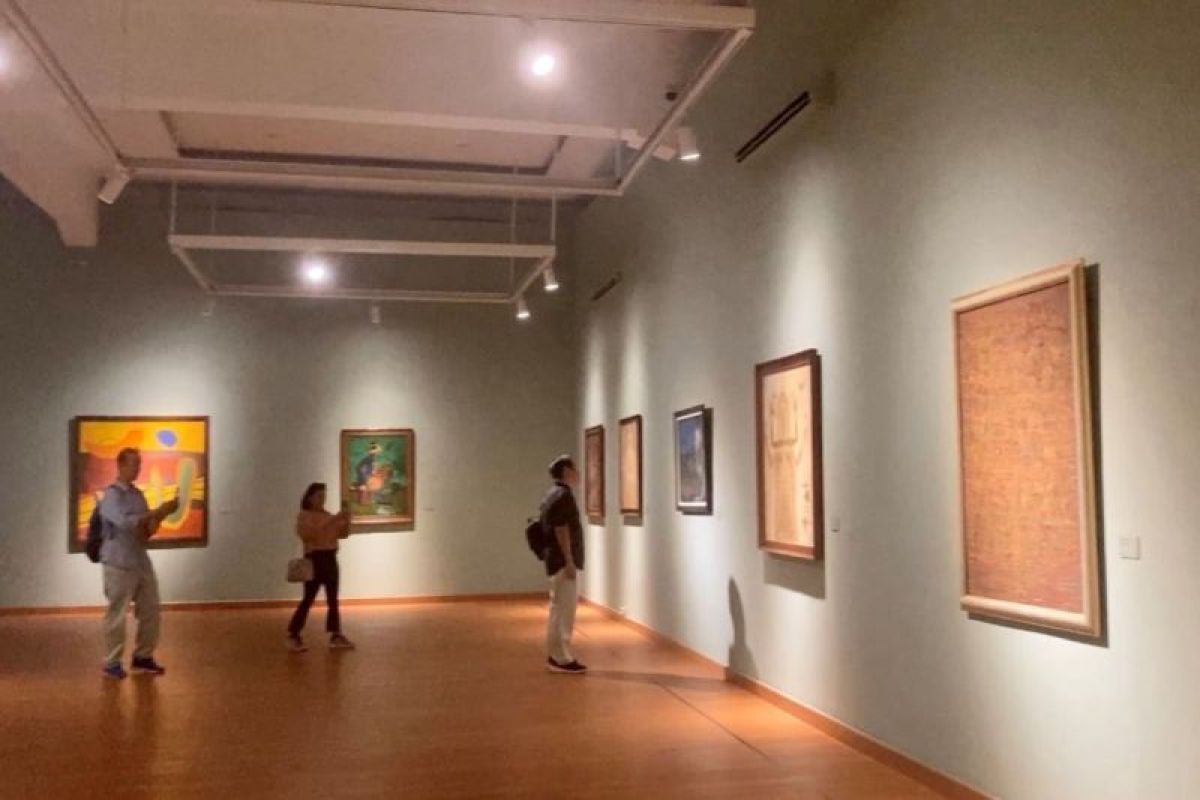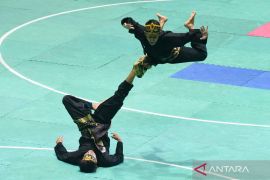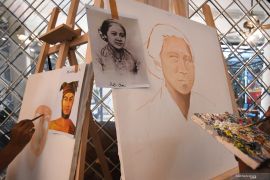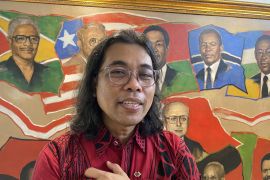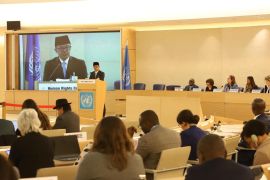Before the 1970s, the artworks in Indonesia were closely intertwined with politics.
In 1965, a military coup, known as the 30 September Movement, broke out. Suharto, the commander of the Army's Strategic Reserve, seized the opportunity to overthrow President Sukarno, who leaned toward socialism.
The conflict between the supporters of populist aesthetics, who were motivated by politics, and the followers of humanism, who supported freedom of speech, had also come to an end with the emergence of the New Order era under Suharto's administration.
Consequently, artists during this period embarked on a quest to define the next artistic paradigm for Indonesian art.
‘70s Picnic (Piknik ’70-an) is an exhibition currently being held at the National Gallery of Indonesia until August 31, with the objective of presenting the diversity of artworks from the 1970s that refresh the visitors’ minds and helps them to let go of their burdens, similar to a picnic trip.
Organized by the National Gallery of Indonesia, along with Museums and Cultural Heritage and the Ministry of Education, Culture, Research, and Technology, the exhibition features 65 works by 54 artists.
Apart from the main exhibition, there is also a children and family activity room, including a painting area, game area, and a creative lab that allows people to do graffiti on the calico wall.
Based on the distinct artistic tendencies, the collections in the exhibition can be divided into five categories, comprising the lyrical and the decorative, significant forms, the archipelagic image, the exploration of materiality, and the exploration of new forms.
The Lyrical and The Decorative
The dominance of the lyrical and the decorative can be seen through artists, such as Irsam, Widayat, and A.D. Pirous, who received the “Five Best Paintings” award at the 1974 Exhibition of Indonesian Painting (PBSLI), the largest art exhibition at that time.
Unlike the previous period, which is politics-oriented, the lyricism reflects the artist’s emotions and inner thoughts in an imaginative approach while the emphasis of the decorative style lies in the detailed depiction of the ornaments or decorations in various areas of the paintings.
One representative work in this category is “Sun Over The Park” by Irsam, which won the best painting award at PBSLI, according to Nanan Kusasi, the guide of the ‘70s picnic.
“In this painting, Irsam employs a decorative approach in this painting, with patterns at the bottom half symbolizing flowers and leaves in the park,” Kusasi explained.
“What I like the most in this painting is how the dark blank background makes the sun stand out, highlighting its brightness,” Kusasi remarked.
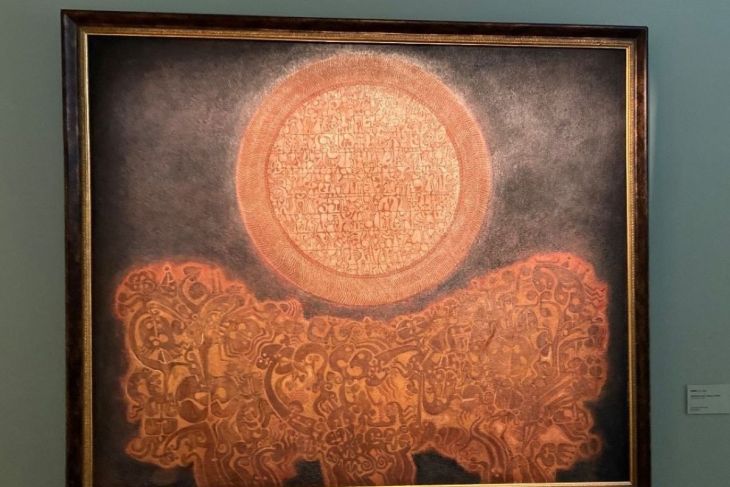
Abas Alibasyah's "War" is another timeless piece that is honored by PBSLI.
“This is also one of the most interesting works to me, in which the artist uses decorative patterns and vibrant colors to represent war,” Kusasi remarked.
“When I first saw this work, I was confused about why he uses bright colors to depict the war. Then, I realized that the war may also symbolize the inner conflict, reflecting the artist’s deepest feelings and emotions through lyricism,” Kusasi explained.
Significant Forms
The trend of formalism initially emerged within the circles of the Fine Art Department of Bandung Institute of Technology during the 1950s.
It then gained greater stability in the 1970s, which can be observed through the shift in public space artworks from realism styles to formalism.
In the aesthetic of formalism, an artwork may incorporate significant forms or geometric elements that evoke emotional sensations, regardless of the symbolic meaning of the components or narrative contents being presented.
Artworks in this category seek the purism of aesthetic language, avoiding the explicit political theme that characterized the previous period.
A painting by Srihadi Soedarsono, titled “Beach,” captured the attention of several visitors.
“I love ’Beach’ so much. It provides comfort and a sense of calm,” Yuawen, a visitor from Bali, stated, adding that it is her favorite artwork at this exhibition.
“Following the approach of formalism, the artist simplified the sky, the sea, and the beach in this painting,” according to Rizki Dhifan, another guide at the exhibition.
Moreover, the depiction of the person’s behavior in the painting is also abstract, but it leaves room for viewers to interpret, Kusasi remarked.
The Archipelagic Image
At the beginning of the New Order regime, the pursuit of national identity remained a prevailing theme in artworks, motivating artists to explore Indonesia's ethnic cultures extensively within their creations.
Artists in this category chose ethnic traditions as the theme of their works but adopted the infusion of modern artistic expression.
In 1973, Bandung, A.D. Pirous, Gregorius Sidharta, and Adrian Palar founded Decenta (Design Center Association), a limited liability company specializing in design that gained a reputation from both private and state institutions.
“Interestingly, some artists did not necessarily come from the regions depicted in their works. For example, the painting ‘Irian Image,’ which portrays the life of Papua’s people, was created by Sunaryo from Bandung,” Dhifan noted.
Some artists depicted their hometowns while others ventured beyond, but overall, the collective goal in this category was to extend the essence of local Indonesian arts and culture, Dhifan remarked.
The Exploration of Materiality
One of the trends that emerged in the 1970s, particularly among several artists in Yogyakarta and Bandung, was the exploration of local materials, including iron welding and batik paintings, as mediums for creating artworks.
The art scene of that era adhered to a strict distinction between art and craft, according to Dhifan.
“Therefore, using unconventional materials was considered an innovative approach during that time,” Dhifan added.
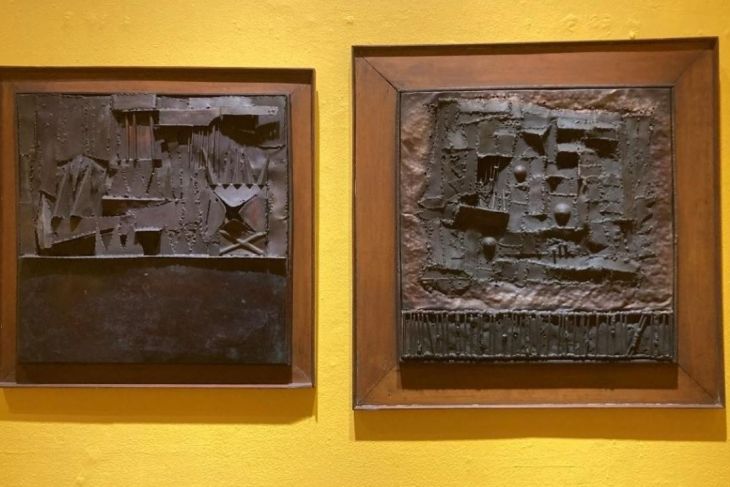
Abdul Kholim, who had a background in welding, used copper as the material in his work “Texture Path I & II,” which demonstrates how different techniques can influence the ultimate outcome of an artwork and makes this work unique, Dhifan explained.
Nevertheless, this practice did not fully develop beyond the 1970s.
The Exploration of New Forms
In 1974, the Indonesian Painting Exhibition awarded “five best paintings” to five senior painters in the decorative style, incurring discontent among young artists.
This decision led the young artists to release the Black December Statement, in which they criticized the lack of social and political consciousness in the decorative style.
One year later, young artists from Yogyakarta and Bandung organized the New Indonesian Art Exhibition ’75, showcasing controversial ready-made works, assemblages, and installations in opposition to the exclusivity of fine arts, followed by the declaration of the Indonesian New Art Movement.
Artists falling under the exploration of new forms are daring to challenge traditional norms and push artistic boundaries by experimenting with alternative materials, techniques, and concepts.
“Among the five different styles in this exhibition, I love the exploration of new forms because the artworks of this style look very classy,” Khadaffy Febrian, a student from the University of Indonesia, remarked.
Febrian pointed out that his favorite artwork is “Xbox” by Jim Supangkat because the combination of the cross, triumph, basket, and warning lamp is contradictory but elegant.
Artworks in this category also usually serve as a vehicle for young artists to reflect their sarcasm on society or politics.
“The General,” an installation by Nyoman Nuarta showing an upper body in military uniform and several heads, is one of the examples.
“Through ‘The General,’ the artist aims to convey that the results are all going to be the same as long as those in political authority enforce a military dictatorship, criticizing Suharto’s government in a subtle way,” Dhifan explained.
With diverse artistic styles flourishing at the same time, Indonesian art in the 1970s created its unique charm that led viewers to a fascinating picnic trip.
Related news: Painting maestro Basoeki Abdullah still inspiring young artists
Related news: Govt invites 45 international youth to learn about Indonesian culture
Editor: Sri Haryati
Copyright © ANTARA 2023
